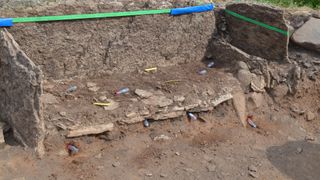
The stone-lined burial chamber was found during excavations of a Neolithic dolmen tomb. Archaeologists think it dates to 3500 B.C. and is one of the oldest tombs in Sweden.
(Image credit: Karl-Göran Sjögren)
Archaeologists in central Sweden have unearthed a 5,500-year-old stone chamber containing several burials from the Early Neolithic period — but many of the largest bones, including skulls, seem to have been removed around the time the dead were placed there.
“This differs from what we usually see in megalithic graves,” Karl-Göran Sjögren, an archaeologist at the University of Gothenburg in Sweden and first author of a new study about the find, said in a statement. “Usually, the bones that are missing are smaller bones from feet and hands.”
The researchers suggest the missing bones may have ties with the traditions of the time and place, but they can’t be sure. “We don’t know whether that has to do with burial rituals, or what’s behind it,” Sjögren said.
The stone chamber was found in the summer of 2023 in the village of Tiarp near the town of Falköping, about 70 miles (114 kilometers) northeast of Gothenburg, according to the study, which was published Dec. 22, 2023 in the Journal of Neolithic Archaeology.
Archaeologists discovered the chamber while excavating a dolmen — a prehistoric tomb made from several large stones.
Related: 2,700-year-old petroglyphs depicting people, ships and animals discovered in Sweden

The excavation of the Neolithic tomb last summer was carried out by archaeologists from Sweden’s University of Gothenburg and Lund University, and Kiel University in Germany. (Image credit: Karl-Göran Sjögren)
Thousands of such structures have been found throughout Europe, as well as some in other parts of the world, including the Western Sahara and Korea. Many seem to date from the Late Neolithic period, roughly 5,000 years ago — the last phase of the Stone Age, before people started smelting copper, bronze and other metals but after they had adopted early agricultural and animal domestication techniques.
The archaeologists say the dolmen at Tiarp was built in about 3500 B.C. and is one of the earliest in the country, although there is evidence of even earlier burials in Sweden, including one that may be up to 8,000 years old.
Ancient bones

The tomb is one of the oldest ever found in Sweden. Several skulls and large bones have been removed, which the archaeologists suggest may have been because of burial rituals. (Image credit: Karl-Göran Sjögren)
Inside the burial chamber, researchers unearthed hand and feet bones, fragments of ribs and teeth from at least 12 people, including infants and the elderly — but very few skulls and larger bones, such as thigh and arm bones.
The archaeologists say the tomb has been untouched since the Stone Age, and so the missing bones seem to have been removed when the people were buried there or soon afterward. While the team can’t yet determine how these Neolithic people died, the interred bones bear no signs of violence.
“We haven’t seen any injuries on the people buried, so we don’t think violence is involved,” Sjögren said. “But we are continuing to study their DNA and that will show whether they had any diseases.”
DNA studies should also show if the people buried in the tomb were related.
“The preliminary DNA results show that the DNA in the bones is well-preserved,” he said. “This means we will be able to reconstruct the family relationships between the people in the grave and we are working on that now.”
The Falköping region is famous for its many Neolithic passage tombs, which have stone burial chambers accessed by narrow passages. But the newly excavated dolmen is older than these.
“It’s about 200 to 150 years older than the passage graves, making it one of the oldest stone burial chambers in Sweden and across the whole of Scandinavia,” Sjögren said.
Early farming techniques reached the region about 500 years before the tomb at Tiarp was built, and so it’s likely that the people buried there were farmers. A chemical analysis of the bones also indicates these individuals lived in a type of agrarian society.
“They lived by growing grain and keeping animals, and they consumed dairy products,” Sjögren said.
Get the world’s most fascinating discoveries delivered straight to your inbox.
Tom Metcalfe is a freelance journalist and regular Live Science contributor who is based in London in the United Kingdom. Tom writes mainly about science, space, archaeology, the Earth and the oceans. He has also written for the BBC, NBC News, National Geographic, Scientific American, Air & Space, and many others.
>>> Read full article>>>
Copyright for syndicated content belongs to the linked Source : Live Science – https://www.livescience.com/archaeology/1-of-swedens-oldest-stone-tombs-is-mysteriously-missing-skulls










